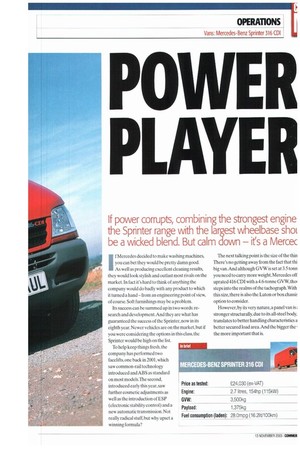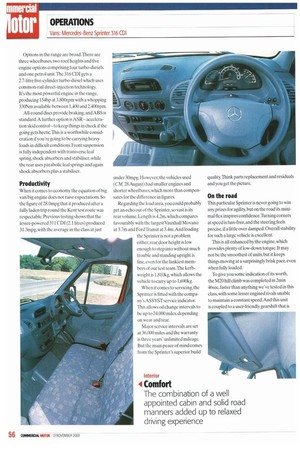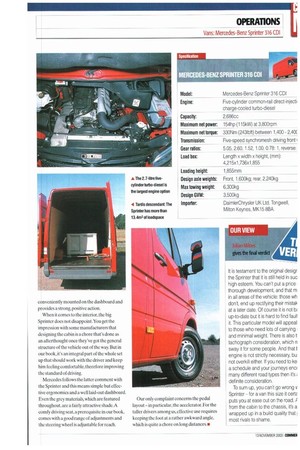OWE It
Page 55

Page 56

Page 57

If you've noticed an error in this article please click here to report it so we can fix it.
AYR
If power corrupts, combining the strongest engine the Sprinter range with the largest wheelbase shoi be a wicked blend. But calm down — ifs a Mercec
If Mercedes decided to make washing machines, you can bet they would be pretty damn good. As well as producing excellent cleaning results, they would look stylish and outlast most rivals on the market. In fact it's hard to think of anything the company would do badly with any product to which it turned a hand — from an engineering point of view, of course. Soft furnishings may he a problem.
Its success can be summed up in two words: research and development.And they are what has guaranteed the success of the Sprinter, now in its eighth year. Newer vehicles are on the market, but if you were considering the options in this class, the Sprinter would be high on the list.
To help keep things fresh, the company has performed two facelifts, one back in 2001, which saw common-rail technology introduced and ABS as standard on most models.The second, introduced early this year, saw further cosmetic adjustments as well as the introduction of ESP (electronic stability control) and a new automatic transmission. Not really radical stuff, but why upset a winning formula? The next talking point is the size of the thin There's no getting away from the fact that thi big van.And although GVW is set at 3.5 tonn you need to carry more weight, Mercedes off uprated 416 CDI with a 4.6-tonne GVW, tho; steps into the realms of the tachograph. With this size, there is also the Luton or box chassi5 option to consider.
However, by its very nature, a panel van is ; stronger structurally, due to its all-steel body, translates to better handling characteristics a better secured load area.And the bigger the the more important that is Options in the range are broad.There are three wheelbases, two roof heights and five engine options comprising four turbo-diesels and one petrol unit.The 316 CD1 gets a 2.7-litre five-cylinder turbo-diesel which uses common-rail direct-injection technology. It's the most powerful engine in the range, producing 154hp at 3,800rpm with a whopping 330Nm available between 1,400 and 2,400rpm.
All-round discs provide braking, and ABS is standard.A further option is ASR —acceleration skid control—to keep things in check if the going gets hectic.This is a worthwhile consideration if you're going to be carrying heavy loads in difficult conditions. Front suspension is fully independent with transverse leaf spring,shock absorbers and stabiliser, while the rear uses parabolic leaf springs and again shock absorbers plus a stabiliser.
Productivity
When it comes to economy the equation of big van/big engine does not raise expectations. So the figure of 28.0mpg that it produced after a fully laden trip round the Kent test route was respectable. Previous testing shows that the lesser-powered 311 CDI (2.1 litres) produced 31.3mpg, with the average in the class at just under 30mpg. However, the vehicles used (CM, 28 August) had smaller engines and shorter wheelbases,which more than compensates for the difference in figures.
Regarding the load area. you could probably get an echo out of the Sprinter, so vast is its rear volume. Length is 4.2m, which compares favourably with the largest Vauxhall Movano at 3.7m and Ford Transit at 3.4m.And loading the Sprinter is not a problem either; rear door height is low enough to step into without much trouble and standing upright is fine, even for the lankiest members of our test team.The kerbweight is 1,810kg. which allows the vehicle to carry up to 1,690kg.
When it comes to servieing,the Sprinter is fitted with the company's ASSYST service indicator. This allows oil change intervals to be up to 24,000 miles, depending on wear and tear.
Major service intervals are set at 36,000 miles and the warranty is three years' unlimited mileage. But the main peace of mind comes from the Sprinter's superior build quality. Think parts replacement and residuals and you get the picture.
On the road
This particular Sprinter is never going to win any prizes for agility, but on the road its minimal flex inspires confidence.Thming corners at speed is fuss-free, and the steering feels precise, if a little over damped. Overall stability for such a large vehicle is excellent.
This is all enhanced by the engine, which provides plenty of low-down torque. It may not be the smoothest of units, but it keeps things moving at a surprisingly brisk pace, even when fully loaded.
To give you some indication of its worth, the M20 hill climb was completed in 2min 46sec,faster than anything we've tested in this class, with some lesser engined rivals unable to maintain a constant speed. And this unit is coupled to a user-friendly gearshift that is conveniently mounted on the dashboard and provides a strong, positive action.
When it comes to the interior, the big Sprinter does not disappoint. You get the impression with some manufacturers that designing the cabin is a chore that's done as an afterthought once they've got the general structure of the vehicle out of the way. But in our book,it's an integral part of the whole set up that should work with the driver and keep him feeling comfortable, therefore improving the standard of driving.
Mercedes follows the latter comment with the Sprinter and this means simple but effective ergonomics and a well laid-out dashboard. Even the grey materials, which are featured throughout, are a fairly attractive shade.A comfy driving seat, a prerequisite in our book, comes with a good range of adjustments and the steering wheel is adjustable for reach. Our only complaint concerns the pedal layout -in particular, the accelerator. For the taller drivers among us, effective use requires keeping the foot at a rather awkward angle, which is quite a chore on long distances. • It is testament to the original desigr the Sprinter that it is still held in suc high esteem. You can't put a price thorough development, and that m in all areas of the vehicle: those wh don't, end up rectifying their mistak at a later date. Of course it is not bi up-to-date but it is hard to find faull it. This particular model will appeal to those who need lots of carrying : and minimal weight. There is also t tachograph consideration, which n sway it for some people. And that t engine is not strictly necessary, bu not overkill either. If you need to kei a schedule and your journeys enct many different road types then it's ; definite consideration.
To sum up, you can't go wrong v Sprinter for a van this size it certz puts you at ease out on the road. from the cabin to the chassis, it's a wrapped up in a build quality that most rivals to shame.
































































































































































































